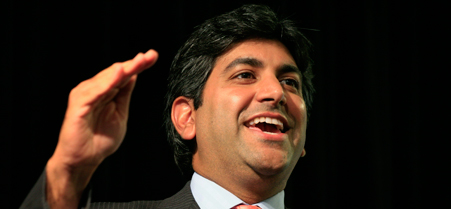OMB to issue transparency directive within a few weeks
Officials say guidance strikes a balance between technology and policies, and reflects public's recommendations.
 Federal Chief Technology Officer Aneesh Chopra submitted recommendations for open government directive.
Federal Chief Technology Officer Aneesh Chopra submitted recommendations for open government directive.
The Obama administration is poised to issue a long-awaited open government directive as soon as two weeks from now that strikes a balance between new information technology and new policies, White House officials said.
One of the president's first official acts on Jan. 21 was to issue a memo directing the person in the new position of federal chief technology officer to recommend within 120 days steps agencies should take to foster collaboration, participation and transparency in government. But the recommendations did not arrive on May 21, because CTO Aneesh Chopra was not confirmed until that day.
Office of Management and Budget spokesman Tom Gavin said on Thursday that Chopra has made his recommendations. "We are close," he added. "In the next few weeks at most. In the next couple weeks, at best," assuring that the document would be out by the end of October.
OMB Director Peter R. Orszag will issue the formal guidance. "It will echo many of the recommendations made by the public," Gavin said.
This spring and summer, Chopra, along with the White House's Office of Science and Technology Policy, conducted a three-part consultation period with the public through wikis -- Web pages that any user can edit -- online voting and blogs before drafting the recommendations.
For the past several weeks, OMB has been examining Chopra's recommendations and agencies' capacity to deploy them. Officials are aware, for example, that not much agency information exists in machine-readable formats that can be immediately pushed out to users through feeds, as the public and Chopra have requested.
Chopra revealed some of his recommendations Sept. 9 at a government transparency conference in Washington. Nextgov was a media sponsor for the event. Chopra said agencies will be directed to devise their individual plans for open government. They will have to flesh out certain required items, including an explanation of how they will engage the public in policymaking. The directive also will require interactive Web sites in the same vein as the IT Dashboard at USAspending.gov, which graphs the progress and costs of IT programs.
Sean Moulton, director of federal information policy at accountability group OMB Watch, said Chopra's comments had a decidedly technical focus that concerned him. The organization favors proposals that would change the fundamental management of information in government, not just the publishing of information.
"I immediately got somewhat worried that there wouldn't be real policy change," he said. "You want some fairly rigorous standards being set through this directive process." OMB Watch has pointed to the White House's recent decision to disclose the names of lobbyists and other visitors to the White House as an example.
Moulton also cautioned that deferring to agencies on individual department guidelines could dilute the whole transparency effort. "Some agencies are just more firmly entrenched in a culture of secrecy," he said. "If the administration is really serious about consistently overturning this culture of withholding and of secrecy, there have to be some pretty clear standards that have the stamp of approval at the highest level."
Participants in the public comment phase pressed for more technical changes in the way government operates. Web-focused areas of interest included online dispute resolution, enabling participation through new media and putting more data online.
"Both of those viewpoints have been well-articulated, and I think that the president's charge and the actions that the administration has taken to date are a balance between policy and technology," Gavin said.
Those policy actions include a January memo requiring disclosure as the default in releasing information under the Freedom of Information Act, he said. The technology strides include an online service the U.S. Citizenship and Immigration Services introduced in September to inform applicants about processing times and more specific information than ever before on the progress of their cases.
Gavin stressed that the guidance does not represent the end of the administration's efforts to bring openness and transparency to the federal government.
In discussions with OMB officials, Greg Parston, director of the Institute for Health and Public Service Value at consulting firm Accenture, said he got the sense that the directive is not being driven by "wiring," or technology, but by a desire to forge relationships with individuals and communities.
"It's not just about releasing information -- it's about eventually creating partnerships," he said.
OMB is seeking a clearer way of demonstrating to citizens the results of their tax dollars, Parston said. He has found through his global research a correlation between the accountability and transparency of a government and the amount of public trust in that government.
"I think that is really crucial today when government finances are so strained," Parston said. Trust prompts people "to partner with government agencies and others to improve their own social economic well-being."
NEXT STORY: An Earmark Windbag Called MARIAH



